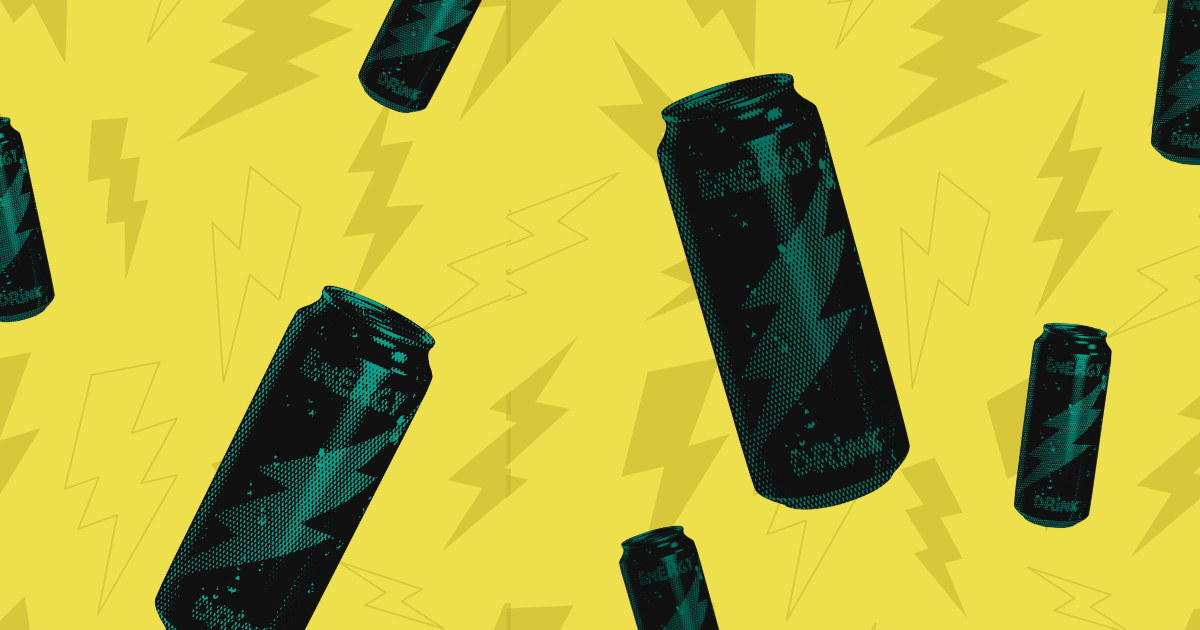.png)
Julie Anderson
Director, MS in Sustainability Management Program, Kogod School of Business
Energy drinks fuel late-night study sessions, high-intensity workouts, and social gatherings across college campuses nationwide. But why do students reach for them? And do they know the health risks? This paper examines the world of energy drinks, exploring their growing popularity among college students, the influence of marketing and branding on consumption, and the critical question of whether companies bear responsibility for their products' health impacts. Through survey research with undergraduate students, we investigate the factors that drive energy drink consumption and the disconnect between health awareness and consumer behavior in today's caffeine-driven campus culture.
RESEARCH MOTIVATION
Since entering the US beverage market in 1997, the popularity of energy drinks has exploded (Harvard); they now represent 63 percent of the US market (Heckman) and 500 new brands have launched since 2006 (Lichvar et al.). Red Bull leads the US energy drink sector with a 43 percent market share (echoing their European dominance) (Lichvar et al.), but big beverage names like PepsiCo and Coca-Cola are eagerly getting involved. Coca-Cola acquired a 16.7 percent stake in Monster in 2015 (Monster Beverage Corporation), while PepsiCo bought Rockstar Energy for $3.85 billion in 2020 (Sampath), and acquired an 8.5 percent stake in Celsius Holdings in 2022 (Lucas).
As the name implies, consumers who buy energy drinks are likely seeking a boost from the main ingredient, caffeine. Caffeine acts as a stimulant by blocking the sleep-promoting neurotransmitter adenosine, giving consumers a sense of energy and mental alertness. While this effect may be beneficial in small doses, the perceived boost does not come without risks. High intake of caffeine has been linked to increased heart rate, high blood pressure, insomnia, and in extreme cases, hospitalization due to caffeine toxicity (Science Direct). Caffeine poses significant risks for younger populations. The American Academy of Pediatrics explicitly "discourages caffeine use by children and adolescents due to its adverse impact on sleep and blood pressure" (Sojar 187). This concern is supported by alarming statistics: emergency room visits linked to energy drinks among individuals aged 12-17 increased from 1,145 in 2007 to 1,499 in 2011 (Harvard). In one tragic case, a 21-year-old with a heart condition died after consuming Panera Bread's highly caffeinated "Charged Lemonade" in 2022. Beyond acute health risks, research indicates long-term dangers as well. Multiple studies demonstrate that regular caffeine consumption can lead to tolerance and addiction-like behaviors, including dependence and withdrawal symptoms when attempting to quit (Vähäkangas). The World Health Organization has formally recognized the severity of this issue by classifying caffeine addiction as a clinical disorder (Hilliard).
The regulatory landscape surrounding caffeine appears inadequate to address these mounting health concerns."
.png)
Ana Pine
MS in Sustainability Management Student, Kogod School of Business
The US Food and Drug Administration (FDA) has abdicated its responsibility by imposing zero restrictions on caffeine content in energy drinks and, even more alarmingly, does not mandate that manufacturers disclose caffeine quantities on product labels (Kole & Barnhill). This regulatory void leaves consumers in the dark about potentially harmful consumption levels. Compounding this problem, the American Beverage Association has only provided voluntary guidelines for energy drink companies (Kole & Barnhill)—an approach that allows manufacturers to prioritize profits over public health with virtually no accountability.
Energy drink companies increasingly target adolescents through strategic cross-promotion, enlisting popular "influencers" to persuade young consumers to emulate them through product purchases. Red Bull exemplifies this approach, establishing strong associations with high-adrenaline sports including Formula 1, X Games, and motocross (Heckman et al.). Adolescents prove "particularly susceptible" to these internet and influencer marketing tactics due to their "high media consumption and active social lives" (Akanni 8). Further enhancing youth appeal, companies deliberately position their products at eye-level in stores, frequently adjacent to candy and snacks—a calculated placement that ensures visibility while normalizing energy drinks as casual "grab and go" items.
SURVEY
We conducted a thorough 27-question survey that began with a strategic reading exercise. This design allowed us to test whether recency bias influences perceptions of caffeine-related health risks. Participants were randomly divided into two groups: one group read about the pros and cons of caffeine consumption, while the other read about the benefits and challenges of dog ownership. We recruited undergraduate students through American University's Kogod School of Business Behavioral Research Lab (B-Lab), a campus facility that connects student participants with academic studies. The survey, administered during Fall 2024, generated 220 valid responses. Our survey focused on four key areas:
- Energy drink consumption and its motivations
- Awareness of related health risks
- Influence of brand and marketing
- Expectations of corporate responsibility
FINDINGS
1. Energy drink consumption and its motivations
Our survey revealed significant insights into student energy drink consumption patterns. Nearly half of all respondents (49.1 percent) reported regular energy drink consumption, indicating widespread popularity among the undergraduate population. Among these energy drink consumers, more than two-thirds (69.3 percent) specifically identified caffeine content as a material factor influencing their decision to consume. When asked about their primary motivation for consuming energy drinks, the need for a "pick me up" was overwhelmingly cited versus other reasons - essentially consumers are using these beverages as a quick solution for fatigue or low energy.
.png?width=2000&height=1050&name=Energy%20Drinks%20and%20Corporate%20Responsibility%20%20Data%20Visuals%20(2).png)
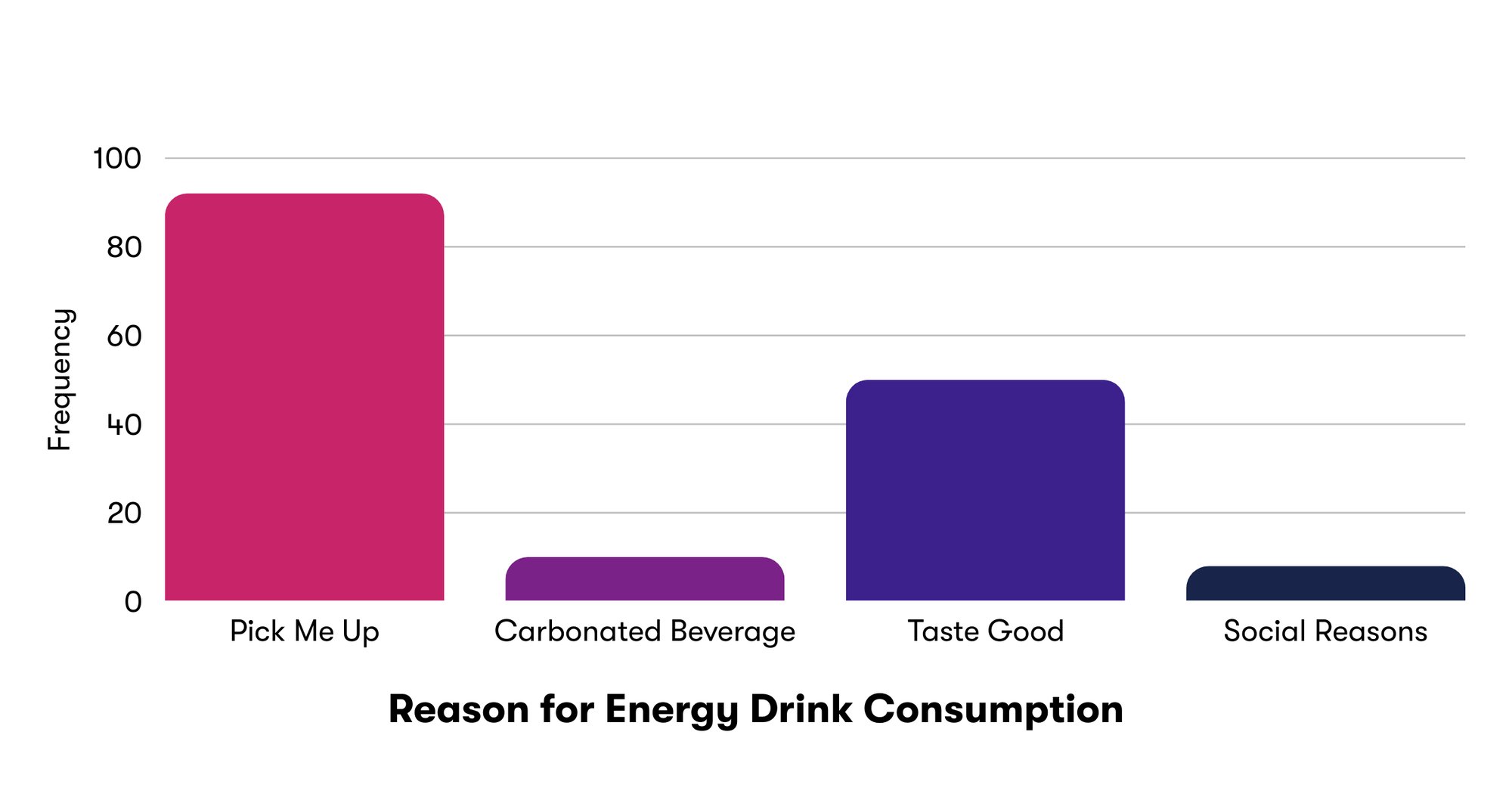
Regarding perceived benefits, over half of energy drink consumers (55.6 percent) reported "mental alertness/studying" as the main benefit they gained from these beverages. This finding indicates that many students rely on energy drinks specifically as an academic performance aid, using caffeine strategically to enhance focus and concentration during study sessions or exams.
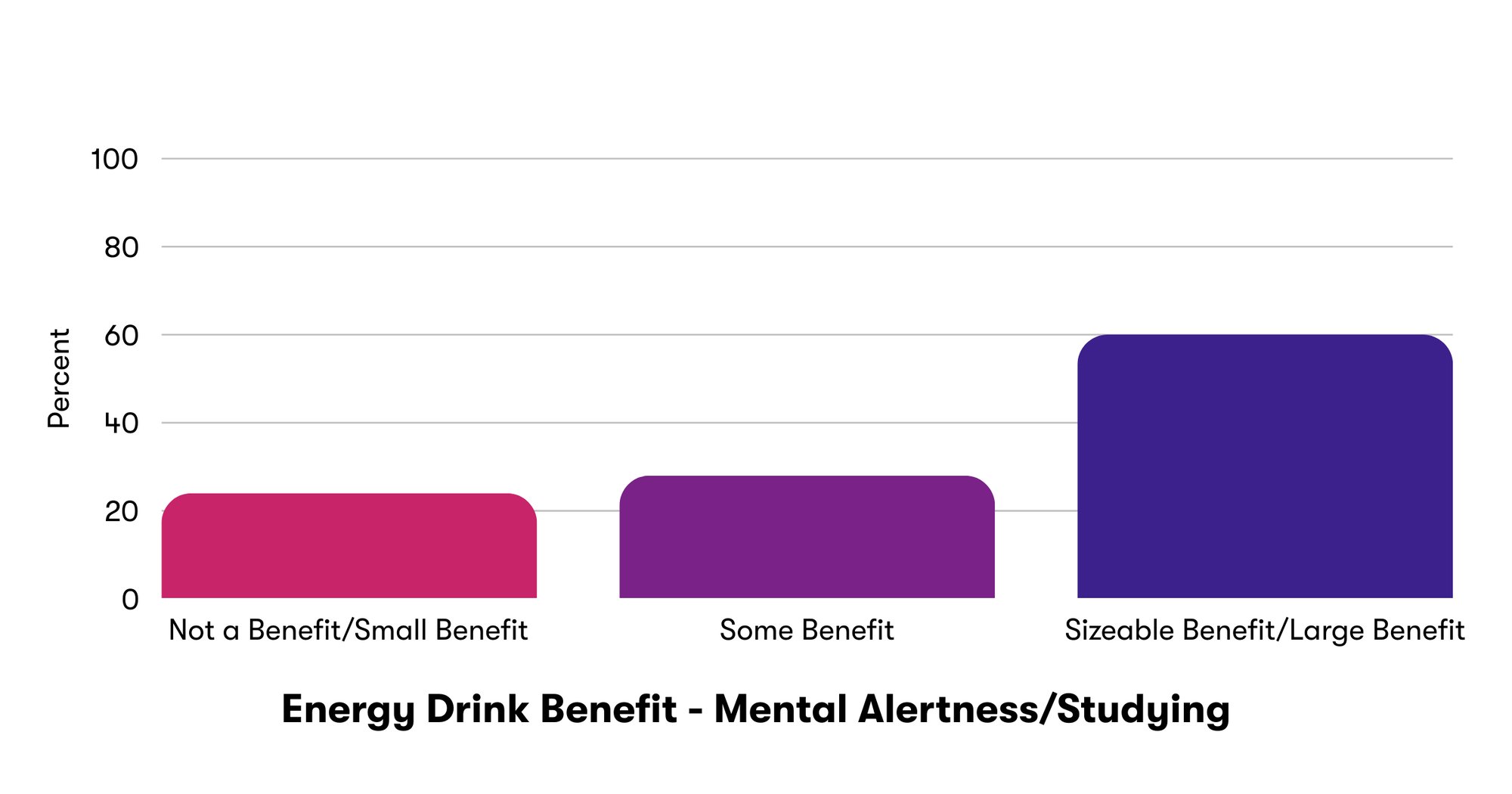
2. Awareness of related health risks
Our findings show widespread awareness of caffeine's health risks among students. Over 90 percent of respondents indicated caffeine consumption "probably" or "definitely" carries health risks. Most students considered 1.5 to 3 cups of coffee acceptable for daily consumption, while 89 percent agreed that 3 to 6.5 cups was unhealthy—a view consistent across both energy drink consumers and non-consumers.
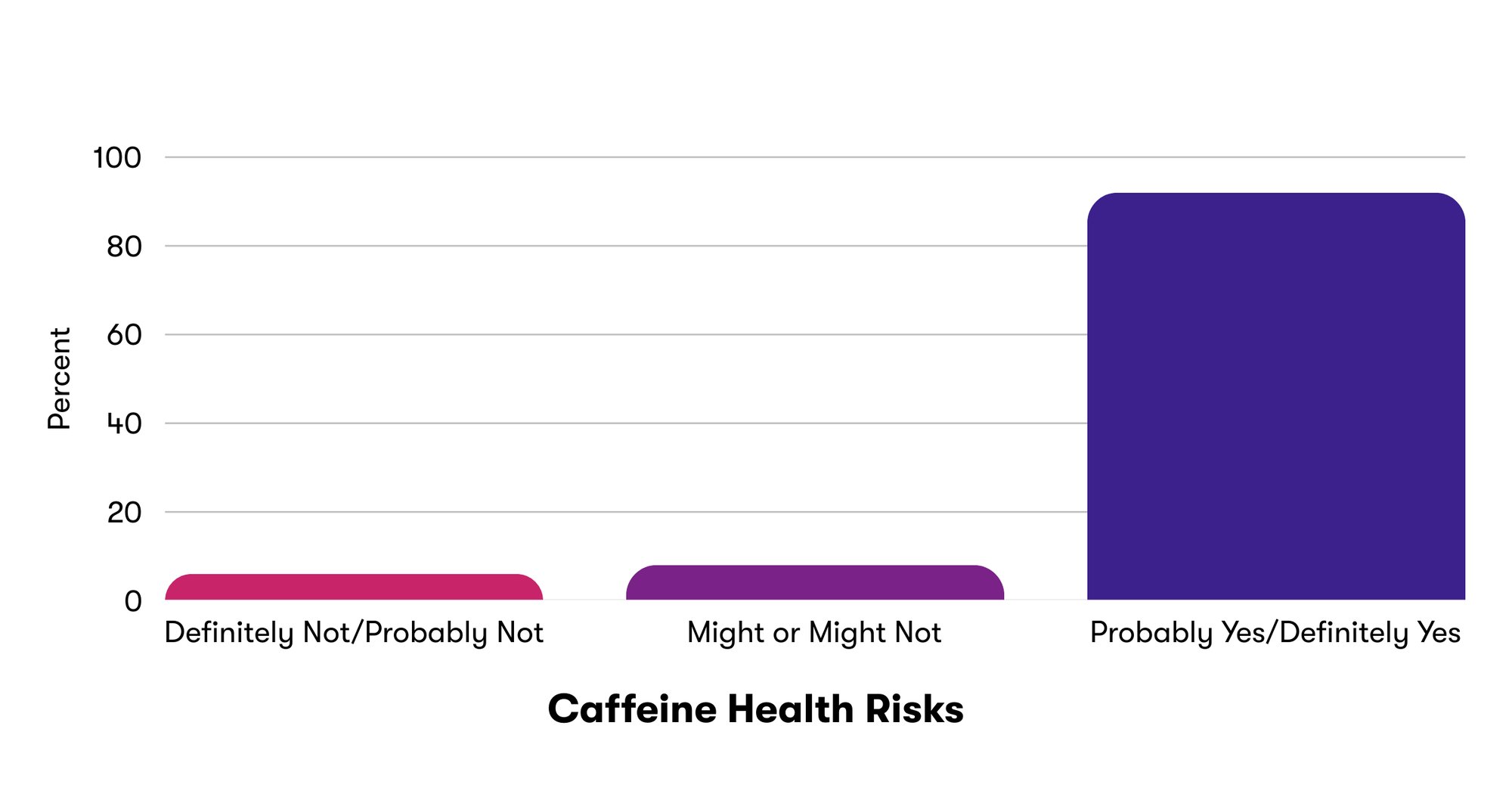
Most students recognized insomnia, anxiety, and rapid heart rate as significant drawbacks of caffeine. Interestingly, only 27 percent of energy drink consumers noted dehydration as a concern, compared to over half of non-consumers. A strong majority of surveyed students believed heavy caffeine consumption is "definitely unhealthy" for teens (72.3 percent) and adults (53.2 percent).
Despite this widespread understanding of health risks, we found no significant correlation between risk awareness and actual energy drink consumption patterns, meaning all students – those that drink energy drinks and those that don’t – understand the health risks of caffeine. Furthermore, education—defined as either previous health class experience or exposure to our pre-survey reading about energy drink pros and cons—did not influence students' awareness of caffeine-related health risks or their decision to consume energy drinks.
3. Influence of brand and marketing
Marketing factors, not education, drive energy drink consumption patterns. Our analysis revealed that reading product fact panels had a minimal impact on consumption decisions. Even students who reported checking these panels "once in a while" showed only a slight difference in behavior, with statistical models demonstrating such poor fit that the relationship lacks meaningful significance (The Nagelkerke’s (pseudo) R square value was 0.045.). This finding aligns logically with our earlier discovery that caffeine content—the primary driver for consumption—typically isn't listed within the energy drink fact panel.
Brand marketing demonstrated much stronger influence on consumption patterns. When assessing various purchasing factors, "brand popularity" emerged as the only variable with substantial impact on energy drink consumption decisions. Students who rated brand popularity as "very" or "extremely important" were 1.82 times more likely to consume energy drinks compared to their peers. This highlights the powerful role of media-based marketing in shaping consumer behavior in our increasingly internet and social media-dependent culture.
4. Expectations of corporate responsibility
When surveyed about corporate responsibility, an overwhelming 88.2 percent of all students affirmed that companies "probably" or "definitely" bear social and moral responsibilities toward their consumers. This conviction transcended consumption habits, with 85.2 percent of energy drink consumers and 91.1 percent of non-consumers sharing this belief. Statistical analysis confirmed no significant difference between these groups—highlighting a remarkable consensus across the student population regardless of personal consumption choices.
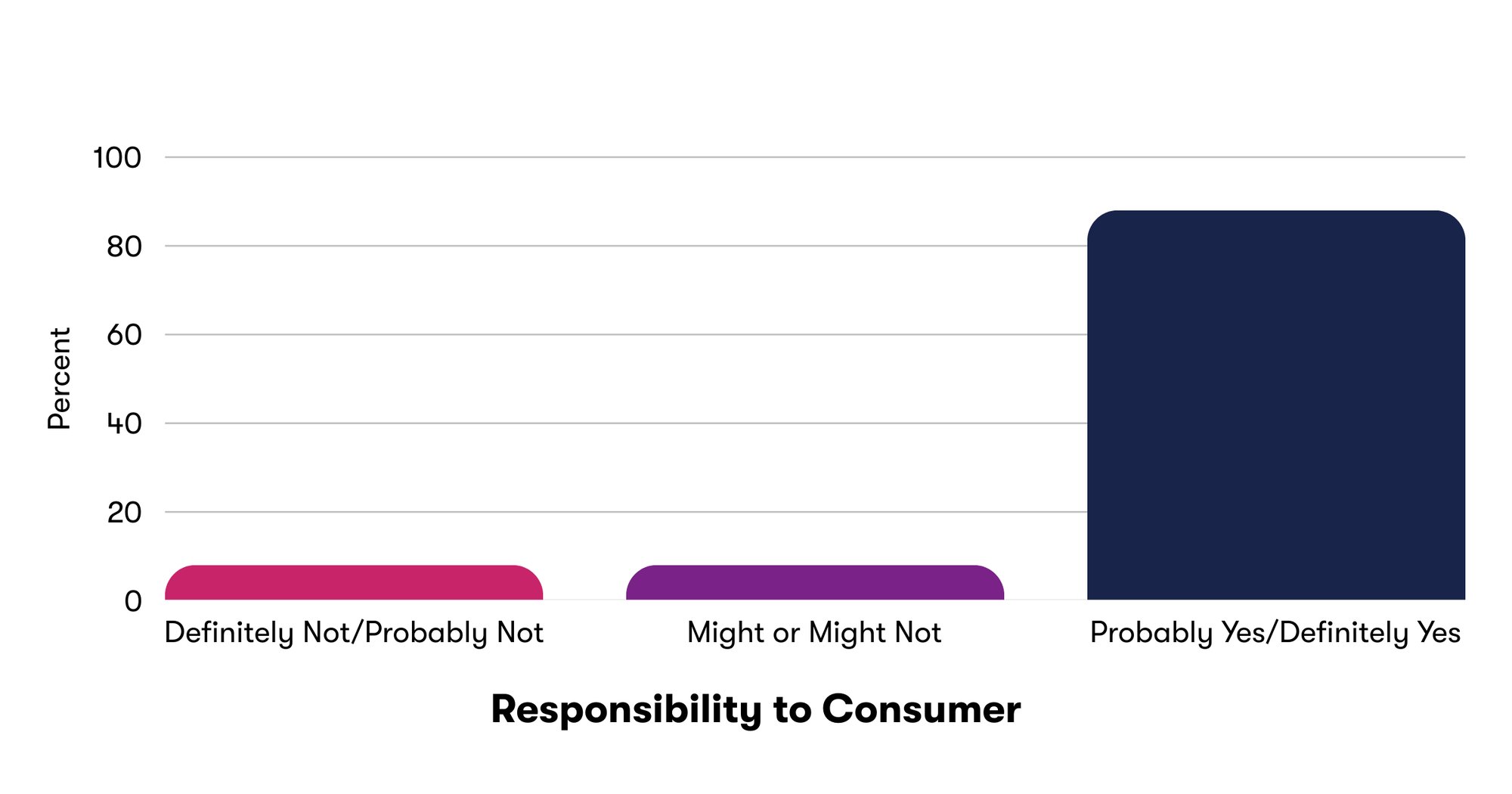
Note: There was no statistically significant difference between the two groups of respondents.
Perhaps even more striking, nearly half (46.8 percent) of all respondents took a particularly strong position, asserting that "taking responsibility for all health issues" falls squarely within a company's obligations. This represents a substantial portion of students who believe corporate accountability should extend beyond mere legal compliance to encompass comprehensive health impacts of their products.
.png?width=2000&height=1050&name=Energy%20Drinks%20and%20Corporate%20Responsibility%20%20Data%20Visuals%20(1).png)
CONCLUSIONS
Cognitive Dissonance in Consumption
Students consume energy drinks primarily for caffeine despite widespread awareness of health risks. This finding aligns with research on substance dependence, where Juliano and Griffiths found that despite awareness of adverse health consequences, many caffeine users report an inability to reduce consumption, highlighting the powerful physiological and psychological components of caffeine dependence that override cognitive knowledge of risks. Energy drink consumers appear to operate under cognitive dissonance—experiencing inner conflict when actions contradict beliefs—and confirmation bias—focusing on positive outcomes while ignoring negative consequences (Miller & Cabell). This psychological pattern mirrors addiction-justifying behaviors.
Strategic Marketing in a Regulatory Vacuum
Energy drink companies exploit weak caffeine regulations and adolescents' susceptibility to brand popularity. Their marketing playbook closely resembles tobacco industry tactics: targeting youth through media-based marketing that emphasizes belonging (Vähäkangas 24), utilizing strategic eye-level product placement proven to "elicit purchase" (Brown et al. 648), and emphasizing performance benefits while downplaying health risks. These practices desensitize consumers—particularly vulnerable adolescents—to potential health risks.
Legal Liability on the Horizon
As consumption increases, energy drink companies may find themselves facing lawsuits similar to those that confronted the tobacco industry. Tobacco companies were prosecuted under the Racketeer Influenced and Corrupt Organizations (RICO) statute for misleading the public about nicotine's addictive nature (Ling & Glantz). Recent cases demonstrate this growing vulnerability: Red Bull paid $13 million in 2014 to settle false advertising claims (Brant), while Panera Bread faced a wrongful death lawsuit in 2023 after a customer with a heart condition died from consuming their highly caffeinated "Charged Lemonade" (Simon Law PC).
The Double Standard: Sugar vs. Caffeine
While major beverage companies acknowledge sugar-related health risks and reformulate products accordingly (PepsiCo, Inc), they largely ignore similar concerns about caffeine. This inconsistency raises a critical question: if sugar warrants caution and product reformulation, why not caffeine?
As public awareness grows and consumer expectations of corporate responsibility strengthen, energy drink companies stand at a crossroads: embrace transparent labeling and ethical marketing or risk significant legal and reputational damage."
.png)
Hannah VanWagner
MS in Sustainability Management Student, Kogod School of Business
IMPLICATIONS
Our research highlights significant implications for regulatory bodies, energy drink companies, and consumers. The limited regulation of caffeine content and labeling for energy drinks poses health risks, especially for adolescents and other vulnerable populations.
Regulatory agencies like the FDA should consider mandating caffeine content disclosure and appropriate warning labels. This transparency should extend to "coffee drinks," which currently avoid caffeine disclosure requirements because the caffeine is "naturally occurring" (Kole & Barnhill). As our research shows, awareness of caffeine-related health risks alone does not impact energy drink consumption, suggesting that additional consumer protections may be beneficial.
The marketing approaches of energy drink companies bear similarities to historical tobacco industry tactics, raising both ethical concerns and potential legal considerations. Like nicotine in tobacco products, caffeine has addictive properties that can lead to dependence and withdrawal symptoms—a parallel further strengthened by the World Health Organization's classification of caffeine addiction as a clinical disorder (Hilliard). The obvious similarity to tobacco-related litigation could eventually implicate major beverage corporations like Pepsi and Coca-Cola through their use of these marketing practices. Companies would benefit from recognizing that potential short-term gains from questionable marketing strategies may not outweigh the "long-term damage to consumer trust and brand loyalty" (Akanni 28).
Thoughtful action from both regulatory bodies and energy drink companies would help promote corporate responsibility while addressing public health concerns. With most consumers believing companies bear responsibility for the health impacts of their products, addressing these issues proactively may serve both ethical and business interests.
REFERENCES
Akanni, Dolapo Abiola. Austrian Student’s Perception of Selected Deceptive Energy Drink Advertisements as a Determinant of Brand Consumption. Master’s thesis, Alpen-Adria-Universität Klagenfurt, 2024. ResearchGate, https://www.researchgate.net/publication/388749725.
Brant, Emma. "So Red Bull Doesn’t Actually 'Give You Wings'." BBC News, 9 Oct. 2014, https://www.bbc.com/news/newsbeat-29550003.
Brown, Jennifer L., et al. “Spinning a Global Web: Tactics Used by Big Tobacco to Attract Children at Tobacco Points-of-Sale.” Tobacco Control, vol. 32, no. 5, 2023, pp. 645–651. BMJ, https://doi.org/10.1136/tobaccocontrol-2021-057095
Harvard T.H. Chan School of Public Health. "Energy Drinks." The Nutrition Source, https://nutritionsource.hsph.harvard.edu/energy-drinks/.
Heckman, M. A., K. Sherry, and E. Gonzalez de Mejia. “Energy Drinks: An Assessment of Their Market Size, Consumer Demographics, Ingredient Profile, Functionality, and Regulations in the United States.” Comprehensive Reviews in Food Science and Food Safety, vol. 9, no. 3, 2010, pp. 303–317. Wiley Online Library, https://doi.org/10.1111/j.1541-4337.2010.00111.x.
Hilliard, Jena. “Caffeine Addiction.” Addiction Center, edited by Addiction Center Team, https://www.addictioncenter.com/stimulants/caffeine/.
Juliano, Laura M., and Roland R. Griffiths. "A Critical Review of Caffeine Withdrawal: Empirical Validation of Symptoms and Signs, Incidence, Severity, and Associated Features." Psychopharmacology, vol. 176, no. 1, 2004, pp. 1–29. Springer-Verlag, https://doi.org/10.1007/s00213-004-2000-x.
Kole, Jon, and Anne Barnhill. "Caffeine Content Labeling: A Missed Opportunity for Promoting Personal and Public Health." Journal of Caffeine Research, vol. 3, no. 3, 2013, pp. 108–113. PubMed Central, https://pmc.ncbi.nlm.nih.gov/articles/PMC3777296/.
Lichvar, Alexandra, et al. "Caffeinated Energy Drinks and Supplements: A Wake-Up Call for Consumers and Healthcare Providers." Patient Safety, vol. 6, no. 1, 2024, https://patientsafetyj.com/article/116073-caffeinated-energy-drinks-and-supplements-a-wake-up-call-for-consumers-and-healthcare-providers.
Ling, Pamela M., and Stanton A. Glantz. “Tobacco Company Strategies to Identify and Promote the Benefits of Nicotine.” Tobacco Control, vol. 28, no. 3, 2019, pp. 289–296. BMJ, https://doi.org/10.1136/tobaccocontrol-2018-054300.
Lucas, Amelia. "PepsiCo Takes $550 Million Stake in Energy Drink Maker Celsius." CNBC, 1 Aug. 2022, https://www.cnbc.com/2022/08/01/pepsico-takes-550-million-stake-in-energy-drink-maker-celsius-.
Miller, Monica K., and Jean J. Cabell. "Confirmation Bias, Cognitive Dissonance, and the COVID-19 Pandemic." The Social Science of the COVID-19 Pandemic: A Call to Action for Researchers, edited by Monica K. Miller, Oxford University Press, 2024, pp. 81–93. Oxford Scholarship Online, https://doi.org/10.1093/oso/9780197615133.003.0006.
Monster Beverage Corporation. "The Coca-Cola Company and Monster Beverage Corporation Close on Previously Announced Strategic Partnership." Monster Beverage Corporation, 12 June 2015, https://investors.monsterbevcorp.com/news-releases/news-release-details/coca-cola-company-and-monster-beverage-corporation-close
PepsiCo, Inc. 2023 ESG Summary. PepsiCo, 2024, https://www.pepsico.com/docs/default-source/sustainability-and-esg-topics/2023-esg-summary/pepsico-2023-esg-summary.pdf?sfvrsn=2fba921a_1.
Sampath Kumar, Uday. "PepsiCo Aims for Energy Boost with $3.85 Billion Rockstar Deal." Reuters, 11 Mar. 2020, https://www.reuters.com/article/us-rockstar-m-a-pepsico/pepsico-aims-for-energy-boost-with-3-85-billion-rockstar-deal-idUSKBN20Y1GT/.
ScienceDirect. "Caffeine Dependence." ScienceDirect Topics, Elsevier, https://www.sciencedirect.com/topics/medicine-and-dentistry/caffeine-dependence.
Simon Law PC. "Panera Charged Lemonade Lawsuits: Do They Have a Case?" Simon Law PC, 13 May 2024, https://simonlawpc.com/defective-products/panera-charged-lemonade-lawsuit/.
Sojar, Sakina H., et al. "Symptoms Attributed to Consumption of Caffeinated Beverages in Adolescents." Journal of Caffeine Research, vol. 5, no. 4, 1 Dec. 2015, pp. 187–191. PubMed Central, https://pmc.ncbi.nlm.nih.gov/articles/PMC4663645/.
The Coca-Cola Company. Form 10-K: Annual Report Pursuant to Section 13 or 15(d) of the Securities Exchange Act of 1934 for the Fiscal Year Ended December 31, 2024. US Securities and Exchange Commission, 21 Feb. 2025, https://investors.coca-colacompany.com/filings-reports/annual-filings-10-k/content/0000021344-25-000011/0000021344-25-000011.pdf.
Vähäkangas, Herman. The Perceived Role of Branding in Consumer Behavior Within the Energy Drink Industry Among Finnish University Students. Bachelor's thesis, Tallinn University of Technology, 2021. [pdf].
